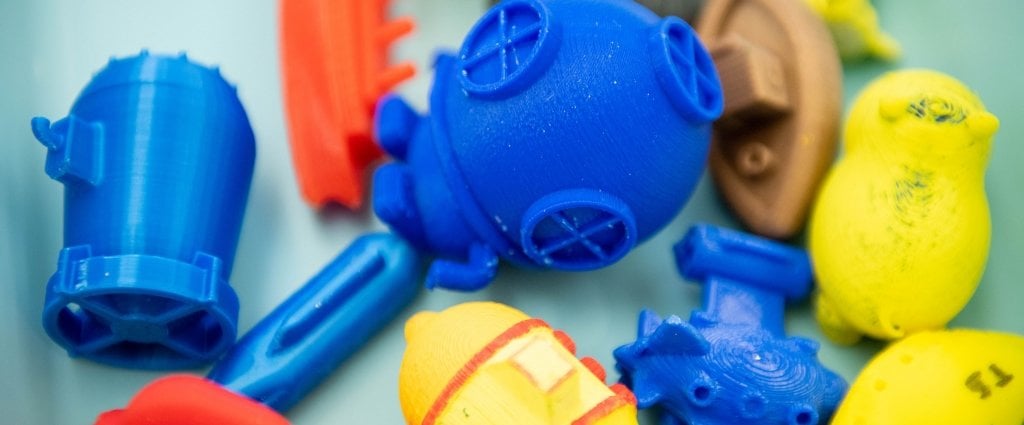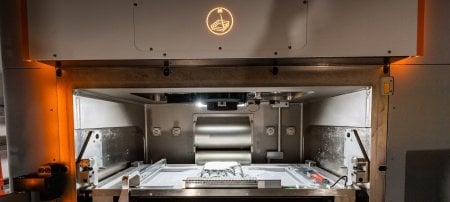Engineering students at Michigan Technological University face challenges on a daily basis. Recently, first-year students had their work evaluated by perhaps the toughest judges they’ll ever face — preschoolers.
Since January, students in Michelle Jarvie-Eggart’s Engineering Fundamentals class have been working on solid modeling projects. The students, who were divided into four-person teams, were tasked with designing a 3D-printed bathtub toy that met three design criteria: it had to float, be self-righting and fit into a 2.5 x 2.5 x 2.5-inch space. The final phase of the project was judging by children at the Michigan Tech Preschool.
Jarvie-Eggart explained her thinking behind the tub-time task. “Our students design 3D models in Siemens NX. They can see their models on screen, but I wanted the projects to come alive for them,” she said.
Creating Work They Can Touch
“I wanted them to design something small enough that they could print out and touch and see as a result of their work. I also wanted it to be open-ended enough to allow for creativity in design and for them to have to consider the needs and perspective of a unique client group.”
The first-year engineering students embraced the challenge, and had fun doing it. Danielle Lund, Wyatt Perry, Sky Hempel and John Mayer were on team “Blue Hippo.” Their tub toy was, of course, a two-inch blue hippopotamus — at least, it was at first.

Hempel said when they put the hippo in water, the blue temporarily changed to a shade of purple. “We didn’t plan on it, but it happened. When I saw it change color, I got excited and I hoped the kids would be excited, too.”
It didn’t take much debate for the team to come up with their design. “We pretty much knew from the start that it was going to be a hippo,” Lund said. “I was wondering how to make it float.”
The toy’s shape allowed it to float rather easily, but then came the hard part.
“The most challenging aspect was to make it self-righting,” Perry said. To accomplish this, the team put small weights in the hippo’s legs. Then tested it. “It worked the first time we tried it,” he said.
The Play's the Thing
Mayer was intrigued by the idea that the toy was going to be played with by preschoolers. “It’s one thing to design a toy, but exciting when you realize someone is actually going to play with this.”
The “unique client group,” as Jarvie-Eggart referred to them, put the toys through their paces Friday, in a “test tub” (a water table) at the preschool. Jarvie-Eggart said this was a bonus: “This project has the added benefits of getting preschoolers excited about engineering. We worked with the Michigan Tech Preschool to align this project with a week where they were studying water.”
Working with about a dozen tub toys with a variety of designs and colors, shifts of three youngsters spent three minutes sinking, sailing, splashing and enjoying the aspiring engineers’ creations.
When asked to pick her favorite, a four-year-old girl lifted a red submarine out of the water. When asked what she liked about it, she pointed to the stern plates and said, “Because it has big spikes.”
A five-year-old boy liked the fact that the toys were small enough to fit in his hand, but cautioned, “They have to be big enough so they won’t go down the drain.”
After everyone had their three minutes, the “judges” cast their votes, but the fun didn’t stop there. They proceeded to a large table where they created a graph of the results. Jarvie-Eggart said, it wasn’t all fun and games. “The audience vote makes up a quarter of the team’s grade for the project. The whole project is worth a total of 20 points. Five for following each of the design criteria and five points based on the opinion of the preschoolers.”
Jarvie-Eggart said she is pleased with the results of the project. “I was overwhelmed by the excitement the students have for this project. Many came to class with initial prototypes and were testing them in cups of water to show them off. They accepted the challenges of the design. The students impressed me by adding a cartoonish quality to many of the designs.”
Sharing the Wealth
Jarvie-Eggart said many of the student’s designs have been uploaded to the website Thingiverse. “Parents and alumni can see designs from our program. They can find free files for 3D printing at home with their kids and grandkids.”
Uploading the designs has advantages that go beyond DIY toy making. “Finding internships is very competitive for first-year students. Our students now can direct potential employers to their designs on Thingiverse. It is one more way to highlight solid modeling skills."
While there were serious implications to the project, Friday’s testing was nicely summed up by one four-year-old — “This is fun!”
Michigan Technological University is an R1 public research university founded in 1885 in Houghton, and is home to nearly 7,500 students from more than 60 countries around the world. Consistently ranked among the best universities in the country for return on investment, Michigan's flagship technological university offers more than 120 undergraduate and graduate degree programs in science and technology, engineering, computing, forestry, business, health professions, humanities, mathematics, social sciences, and the arts. The rural campus is situated just miles from Lake Superior in Michigan's Upper Peninsula, offering year-round opportunities for outdoor adventure.






Comments